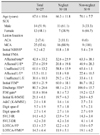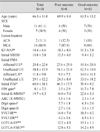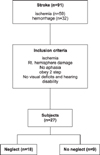1. Bowen A, Lincoln N. Cognitive rehabilitation for spatial neglect following stroke. Cochrane Lib. 2007; 2:1–52.

2. Urbanski MA, De Schotten MT, Rodrigo S, Oppenheim C, Touzé E, Méder JF, Bartolomeo PA. DTI-MR tractography of white matter damage in stroke patients with neglect. Exp Brain Res. 2011; 208(4):491–505.

3. Paolucci S, Antonucci G, Grasso MG, Pizzamiglio L. The role of unilateral spatial neglect in rehabilitation of right brain–damaged ischemic stroke patients: a matched comparison. Arch Phys Med Rehabil. 2001; 82:743–749.

4. Halligan PW, Fink GR, Marshall JC, Vallar G. Spatial cognition: evidence from visual neglect. Trends Cognit Sci. 2003; 7:125–133.

5. Vallar G. Extrapersonal visual unilateral spatial neglect and its neuroanatomy. Neuroimage. 2001; 14:S52–S58.

6. Mesulam MM. Spatial attention and neglect: parietal, frontal andcingulate contributions to the mental representation and attentional targeting of salient extrapersonal events. Phil Trans R Soc Lond B. 1999; 354:1325–1346.

7. Chen P, Chen CC, Hreha K, Goedert KM, Barrett AM. Kessler Foundation Neglect Assessment Process Uniquely Measures Spatial Neglect During Activities of Daily Living. Arch Phys Med Rehabil. 2015; 96(5):869–876.

8. Yoo EY, Jung MY, Park SY, Choi EH. Current trends of Occupational Therapy Assessment Tool by Korean Occupational Therapist. J Korean Soc Occup Ther. 2006; 14(3):27–37.
9. Plummer P, Morris ME, Dunai J. Assessment of unilateral neglect. Phys Ther. 2003; 83:732–740.

10. Chen P, Hreha K, Pitteri M. Kessler Foundation Neglect Assessment Process: KF-NAP 2014 manual. West Orange: Kessler Foundation;2014.
11. Gillen R, Tennen H, McKee T. Unilateral spatial neglect: relation to rehabilitation outcomes in patients with right hemisphere stroke. Arch Phys Med Rehabil. 2005; 86:763–767.

12. Pedersen PM, Jorgensen HS, Nakayama H, Raaschou HO, Olsen TS. Hemineglect in acute stroke—incidence and prognostic implications. The Copenhagen Stroke Study. Am J Phys Med Rehabil. 1997; 76:122–122.
13. Verdon V, Schwartz S, Lovblad KO, et al. Neuroanatomy of hemispatial neglect and its functional components: a study using voxel-based lesion-symptom mapping. Brain. 2010; 133(Pt 3):880–894.

14. Husain M, Rorden C. Non-spatially lateralized mechanisms in hemispatial neglect. Nat Rev Neurosci. 2003; 4:26–36.

15. Chen P, Hreha K. Kessler Foundation Neglect Assessment Process: KF-NAP 2015 manual. West Orange: Kessler Foundation;2015.
16. Wojciulik E, Husain M, Clarke K, Driver J. Spatial working memory deficit in unilateral neglect. Neuropsychologia. 2001; 39(4):390–396.

17. Gainotti G, Tiacci C. The relationships between disorders of visual perception and unilateral spatial neglect. Neuropsychologia. 1971; 9(4):451–158.

18. Kang Y, Na DL. Seoul Neuropsychological Screening Battery (SNSB). 1st ed. Incheon: Human Brain Research & Consulting Co;2003.
19. Katherine Salter BA, Mark Hartley BA, Norine Foley B. Impact of early vs delayed admission to rehabilitation on functional outcomes in persons with stroke. J Rehabil Med. 2006; 38:113–117.

20. Katz N, Itzkovich M, Averbuch S, Elazar B. Loewenstein Occupational Therapy Cognitive Assessment (LOTCA) battery for brain-injured patients: Reliability and validity. Am J Occup Ther. 1989; 43:184–192.

21. Azouvi P, Olivier S, de Montety G, Samuel C, Louis-Dreyfus A, Tesio L. Behavioral Assessment of unilateral neglect: Study of the psychometric properties of the Catherine Bergego Scale. Arch Phys Med Rehabil. 2003; 84(1):51–57.

22. Chen P, Hreha K, Fortis P, Goedert KM, Barrett AM. Functional assessment of spatial neglect: A review of the Catherine Bergego Scale and an introduction of the Kessler Foundation Neglect Assessment Process. Top Stroke Rehabil. 2012; 19:423–435.

23. Ling FM. Stroke Rehabilitation: Predicting Inpatient Length of Stay and Discharge Placement. Hong Kong J Occup Ther. 2004; 14(1):3–11.

24. Moeller T, Rief E. Pocket atlas of sectional anatomy [vol 1 head and neck]. New York: thieme;2007.
25. Karnath HO, Berger MF, Küker W, Rorden C. The anatomy of spatial neglect based on voxelwise statistical analysis: a study of 140 patients. Cerebral Cortex. 2004; 14(10):1164–1172.

26. Karnath HO, Rennig J, Johannsen L, Rorden C. The anatomy underlying acute versus chronic spatial neglect: a longitudinal study. Brain. 2011; 134:903–912.

27. Karnath HO, Himmelbach M, Rorden C. The subcortical anatomy of human spatial neglect: putamen, caudate nucleus and pulvinar. Brain. 2002; 125(2):350–360.

28. Karnath HO, Rorden C, Ticini LF. Damage to white matter fiber tracts in acute spatial neglect. Cerebral Cortex. 2009; 19(10):2331–2337.

29. Wade D, Skilbeck C, David R, Langton-Hewer R. Stroke: a critical approach to diagnosis, treatment and management. London: Chapman and Hall;1985.
30. Driver J, Mattingley JB. Parietal neglect and visual awareness. Nat Neurosci. 1998; 1:17–12.

31. Jehkonen M, Ahonen JP, Dastidar P, et al. Visual neglect as a predictor of functional outcome one year after stroke. Acta Neurol Scand. 2000; 101:195–201.

32. Denes G, Semenza C, Stoppa E, Lis A. Unilateral spatial neglect and recovery from hemiplegia. Brain. 1982; 105(3):543–552.

33. Brain Mort DJ, Malhotra P, Mannan SK, et al. The anatomy of visual neglect. Brain. 2003; 126(Pt 9):1986–1997.

34. Paolucci S, Antonucci G, Grasso MG, Pizzamiglio L. The role of unilateral spatial neglect in rehabilitation of right brain–damaged ischemic stroke patients: a matched comparison. Arch Phys Med Rehabil. 2001; 82(6):743–749.

35. Corbetta M, Kincade MJ, Lewis C, et al. Neural basis and recovery of spatial attention deficits in spatial neglect. Nat Neurosci. 2005; 8:1603–1610.

36. Robertson IH, Mattingley JB, Rorden C, Driver J. Phasic alerting of neglect patients overcomes their spatial deficit in visual awareness. Nature. 1998; 395(6698):169–172.

37. Stone SP, et al. Unilateral neglect: a common but heterogeneous syndrome. Neurology. 1998; 50:1902–1905.

38. Baddeley AD, Hitch GJ. Working memory. In : Bower GA, editor. Recent advances in learning and motivation, Vol. 8. New York: Academic Press;1974. p. 47–90.
39. Katz N, Hartman-Maeir A, Ring H, Soroker N. Relationships of cognitive performance and daily function of clients following right hemisphere stroke: predictive and ecological validity of the LOTCA battery. Occup Participation Healt. 2000; 20(1):3–17.

40. LaBar KS, Gitelman DR, Parrish TB, Mesulam MM. Neuroanatomic overlap of working memory and spatial attention networks: a functional MRI comparison within subjects. Neuroimage. 1999; 10(6):695–704.

41. Hampshire A, Chamberlain SR, Monti MM, Duncan J, Owen AM. The role of the right inferior frontal gyrus: inhibition and attentional control. Neuroimage. 2010; 50(3):1313–1319.

42. Aron AR, Robbins TW, Poldrack RA. Inhibition and the right inferior frontal cortex. Trends Cogn Sci. 2004; 8:170–177.

43. Clower DM, West RA, Lynch JC, Strick PL. The inferior parietal lobule is the target of output from the superior colliculus, hippocampus, and cerebellum. J Neurosci. 2001; 21(16):6283–6291.

44. Corbetta M, Shulman GL. Spatial neglect and attention networks. Annu Rev Neurosci. 2011; 34:569–599.











 PDF
PDF ePub
ePub Citation
Citation Print
Print



 XML Download
XML Download